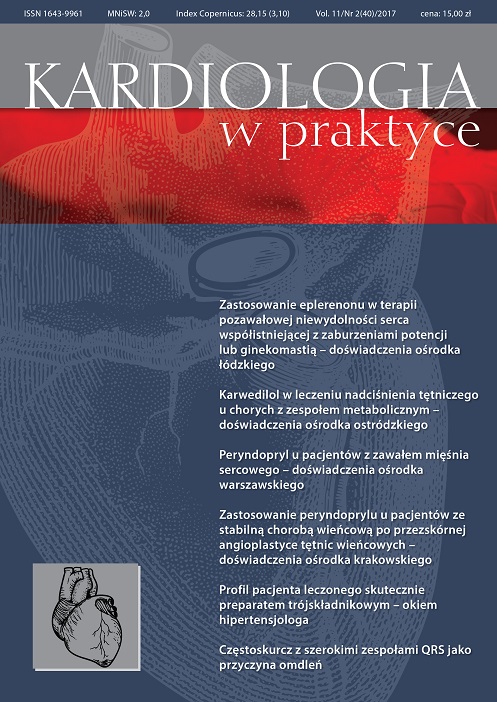Perindopril treatment of patients with stable coronary artery disease undergoing percutaneous coronary intervention – experience of the Cracow center Case report
Main Article Content
Abstract
Angiotensin converting enzyme inhibitors comprise one of the major drug groups commonly used among patients with cardiovascular diseases. Beneficial effect of perindopril has been proven in the large, randomised clinical trials which revealed significant reduction of the risk of death and other major cardiovascular adverse events. In the following article we present 3 case reports of patients hospitalized in the Department of Interventional Cardiology, John Paul II Hospital in Krakow who underwent percutaneous coronary intervention and were prescribed perindopril in adequate dose.
Downloads
Article Details

This work is licensed under a Creative Commons Attribution-NonCommercial 4.0 International License.
Copyright: © Medical Education sp. z o.o. This is an Open Access article distributed under the terms of the Attribution-NonCommercial 4.0 International (CC BY-NC 4.0). License (https://creativecommons.org/licenses/by-nc/4.0/), allowing third parties to copy and redistribute the material in any medium or format and to remix, transform, and build upon the material, provided the original work is properly cited and states its license.
Address reprint requests to: Medical Education, Marcin Kuźma (marcin.kuzma@mededu.pl)
References
2. Montalescot G., Sechtem U., Achenbach S.: Wytyczne ESC dotyczące postępowania w stabilnej chorobie wieńcowej w 2013 roku: dodatek internetowy. Kardiologia Polska 2013; 71, dodatek internetowy: 1-41.
3. Mancia G., Fagard R., Narkiewicz K.: Wytyczne ESH/ESC dotyczące postępowania w nadciśnieniu tętniczym w 2013 roku. Kardiologia Polska 2013; 71(supl. III): 27-118.
4. Ryden L., Grant P.J., Anker S.D.: Wytyczne ESC dotyczące cukrzycy, stanu przedcukrzycowego i chorób układu sercowo-naczyniowego opracowane we współpracy z EASD. Kardiologia Polska 2013; 71(supl. IX): S319-S394.
5. Ponikowski P., Voors A.A., Anker S.D.: Wytyczne ESC dotyczące diagnostyki i leczenia ostrej i przewlekłej niewydolności serca w 2016 roku. Kardiologia Polska 2016; 74(10): 1037-1147.
6. Cardiology Department, Royal Brompton Hospital, Sydney Street, London SW3 6NP, UK, Efficacy of perindopril in reduction of cardiovascular events among patients with stable coronary artery disease: randomised, double-blind, placebo-controlled, multicentre trial (the EUROPA study). Lancet 2003; 362(9386): 782-788.
7. PROGRESS Collaborative Group, c/o Institute for International Health, University of Sydney, PO Box 576, Newtown, Sydney, NSW 2042, Australia: Randomised trial of a perindopril-based blood-pressure-lowering regimen among 6105 individuals with previous stroke or transient ischaemic attack. Lancet 2001; 358: 1033-1041.
8. Patel A., MacMahon S.; ADVANCE Collaborative Group: Effects of a fixed combination of perindopril and indapamide on macrovascular and microvascular outcomes in patients with type 2 diabetes mellitus (the ADVANCE trial): a randomised controlled trial. Lancet 2007; 370(9590): 829-840.
9. Ma T.K., Kam K.K., Yan B.P., Lam Y.Y.: Renin–angiotensin–aldosterone system blockade for cardiovascular diseases: current status. Br. J. Pharmacol. 2010; 160(6): 1273-1292.
10. Pizoń T., Rajzer M., Kameczura T.: Rola układu renina–angiotensyna–aldosteron w etiologii i patogenezie nadciśnienia tętniczego oraz jego powikłań narządowych – co pozostało z koncepcji Laragha i Aldermana? Arterial Hypertension 2011; 15(6): 371-382.
11. Kluk M.K., Wożakowska-Kapłon B.: Perindopril – nieznane oblicza znanego leku. Folia Cardiologica 2014; 9(2): 173-178.

